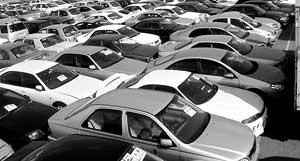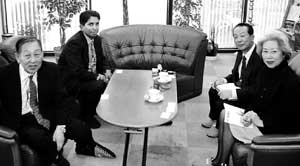
| The Rama group helping Sri Lankan businesses in Japan Jagath Ramanayake went to Japan in the mid 1980s as a student and ended up as a successful businessman in the motor vehicle industry there. Today this 40-year old is not only very successful but is Japan’s second largest used vehicle exporter selling to 65 countries and the first to sell vehicles through the Internet. Now the Sri Lankan businessman is going a step further – encouraging Sri Lankan companies to set up business and trading in Japan and providing a whole range of facilities to help such entrepreneurs. In a telephone interview, Jagath Ramanayake, President and CEO of the Rama Group talks about the motor vehicle industry and other related issues: * A lot of questions are being asked about the car market and its imports from Japan and how the system operates. How did the second hand car market originate? Sri Lanka have been importing for the last 25 years. At that time this industry began I was in Sri Lanka and in 1980-85 only Japanese companies were exporting to Sri Lanka. The Pakistanis were the first foreigners in the Japanese market and local dealers bought from Pakistani exporters too. Countries buying used Japanese cars were Pakistan, Burma, Thailand, Singapore and Malaysia (a little bit).
* What was the cost difference between a new car and a used one? It was huge. Used cars were 45 percent less than new ones -- less than half the cost. It was then five year old cars unlike three-year olds now. That’s how the market grew. Then some Sri Lankan businessmen came to Japan to buy cars like us and began doing business there. By that time the used car market in Japan was growing tremendously. Those days cars were sold at auction centres manually with about 2,000 to 3,000 cars being sold a day. Then it became electronic and now they sell 15,000 cars a day. * Is it per auction or all auctions? Per auction. The biggest auction centre in Japan is on Wednesday and is called the USS Tokyo which sells 10-15,000 cars a day. There are about 3,000 to 5,000 people who come to these auctions a day. That’s how the car market progressed. All used car dealers go to the auctions to buy used cars. Toyota new car dealers did part exchange and sold used cars for low value as the second hand car market was down at the time. Since there was no market, they sent it to a junkyard or sold it to anyone who asked for it. With the auction system, all cities were networked and you could buy cars from anywhere as dealers sent their cars to the auctions. * How many Sri Lankans are involved in the car market there? It’s difficult to say. There maybe those who send 2-3 cars a month. Some send 20, some send 50-100. There would be about 50 Sri Lankan individuals and companies involved. Those sending more than 100 units per month like us could be about five companies. Then 50 to 100 would have another five companies. The rest would be in the 2-3 car-sale bracket. * What are the rules and regulations governing used car exports from Japan?
Earlier there was a JI certificate which the Japanese government imposed and gave a semi-government institution to handle the certification before shipment. Retired officials from the transport ministry joined this institute. This certification was needed because at that time Japan was sending used vehicles as ODA (Overseas Development Assistance). * Was Sri Lanka also getting these under Japanese aid? Maybe construction/heavy vehicles – not cars. Some Latin American countries got used cars under ODA. Those were government-to-government deals and vehicle quality was in question. So they wanted a third party to certify the vehicles. There was a strict inspection certificate and each car dealer had to pay 50,000 Yen for that certificate. * Why do the Japanese dispose of their new cars after a few years? A new car gets a roadworthy license for three years and then you need to go to a workshop and get a compulsory fitness certificate which costs you money like for example changing the brake pad, etc. That was very strict. Subsequently due to local pressure, the regulations were relaxed and the cost of this certification came down. * Why is the disposal rate of used cars high? Because Japanese incomes are high. Their average monthly income is Rs 300,000 to Rs 400,000. In Sri Lanka it’s expensive because the tax is high but in Japan a brand new Corolla would cost Rs 1.2 million. That’s three months salary for the average Japanese. Because of the 3-year certificate issue, the average Japanese takes the car to the dealer who then talks him into a part-exchange for a new car when new models come into the market which is every three years. If for example 100 used cars go out of the market, about 30 percent is used in Japan. This 30 percent of buyers may have less income, want a second car or for other reasons. 10 percent are bought for parts or recondition. The 50-60 percent is exported. * What is the cost difference now between a used car and a new car? It’s quite close … about a 20 percent difference. The reason why people overseas go for used cars is because these vehicles are made for the Japanese market and generally Japan is considering having the best world products in anything. Cars made for the Japanese market are costly. In the case of new cars made for particular markets like Thailand, Russia or any other country, the vehicles are made to suit that budget and consumer buying power. To give it at a lower price, there are changes in maybe the body, engine, etc to suit the buying power of that market. That doesn’t mean the quality of the vehicles suffers; it may have less add-ons. * Are all cars made in Japan now automatic transmission? * How does the auction system work? You must be a member of that auction centre to take part. Auction centres don’t own cars … they are owned by Toyota, Nissan or used car dealers. At the auction you sit at a table that has a unit where you register your card. Thus this centre knows who is sitting at what table by the card number. When you bid, you push a button and that bid is recorded with the member’s number. Payment of the vehicle purchased must be made within a week. Customs’ procedures take 2-3 days and within a week the vehicle could be shipped. It would take three weeks to come to Colombo by ship. * Who guarantees the quality of the vehicle? When the vehicle is sent to the auction, the auction charges a fee of 10,000 Yen – whether the car is sold or not. The auction checks through inspectors about ownership and status of vehicle and provides a report. These reports are given in Japanese and there could be times when a Sri Lankan or Pakistani who doesn’t understand Japanese buys a car that has some flaws. If for example, we find some part missing or something wrong in the car which is not in the report, we can get that missing part from the auction or return the car. This has to be done within five days. * What percentage of used cars imported into Sri Lanka may be faulty because the importer willingly knew or didn’t know? Unknowingly it would be about one percent. Even professionals find it difficult to spot faults. When it comes to a used car, there are these problems because you don’t know how it has been used, etc. Earlier the government monitored these vehicles because they were sent as ODA. But since private parties are now involved, the government leaves it to the two parties (buyer and seller) to decide on any quality issue. In some African countries, they had their own inspections back home but that didn’t work. For example, not seeing rust in a vehicle could also mean that, that portion had been hand-painted. It’s a market-driven mechanism now and if an importer feels he has been cheated, then he goes to a more reliable party. The Japanese government is no more involved in assuring the quality of vehicles that are exported. * What’s your advice to a potential car buyer here? The company you are buying from should have a strong relationship with a reputed car dealer in Japan. Stick with a dealer who imports many cars and not a few. Look for a reputed dealer who can quickly get help from his Japanese partner on parts or advise. Some details about your business: There are some countries that buy one or two cars; there are others that buy 50 cars. We have buyers from 65 countries and 90 percent of our cars are sold through the Internet. * Who are the foreigners, other than Sri Lankans and Pakistanis, in the car export market there? New Zealanders, the British, Bangladesh, Nepal, etc. There is an organization called the Used Motor Vehicles Association which deals with the government. Last year I was elected as one of eight directors and the first foreigner to do so. We have 400 members among the 4-5,000 companies who are used car exporters. * Why are only the Japanese known for exporting used cars? What about other manufacturers in the US, Korea or Europe? The depreciation rate is very high in Japan because they buy a new vehicle every three years unlike in other countries manufacturing cars.
|
| || Front
Page | News
| Editorial
| Columns
| Sports
| Plus
| Financial
Times | International
| Mirror
| TV
Times | Funday
Times || |
| |
Copyright
2006 Wijeya
Newspapers Ltd.Colombo. Sri Lanka. |

